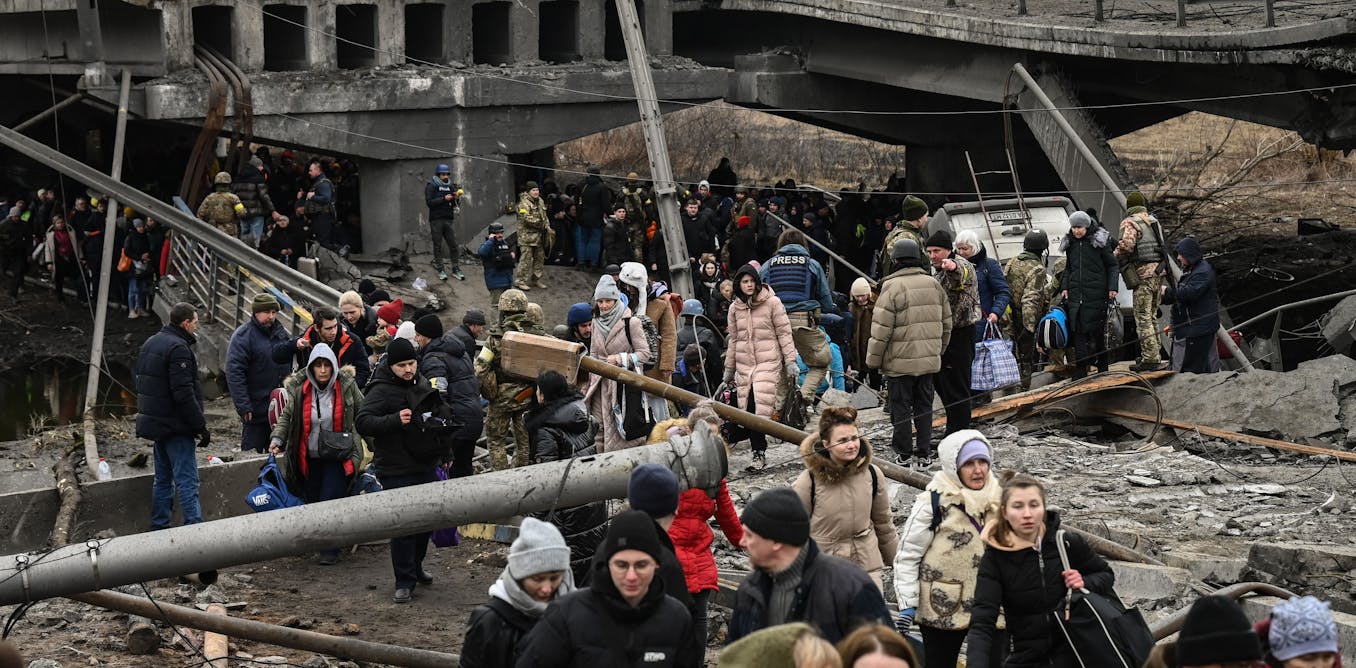
Ukrainian refugees are welcomed with open arms – not so with people fleeing other war-torn countries
The welcome mat for refugees fleeing war-torn Ukraine stands in stark contrast to recent anti-immigrant policies targeting those from the Middle East, Latin America, Africa and Asia.
 theconversation.com
theconversation.com
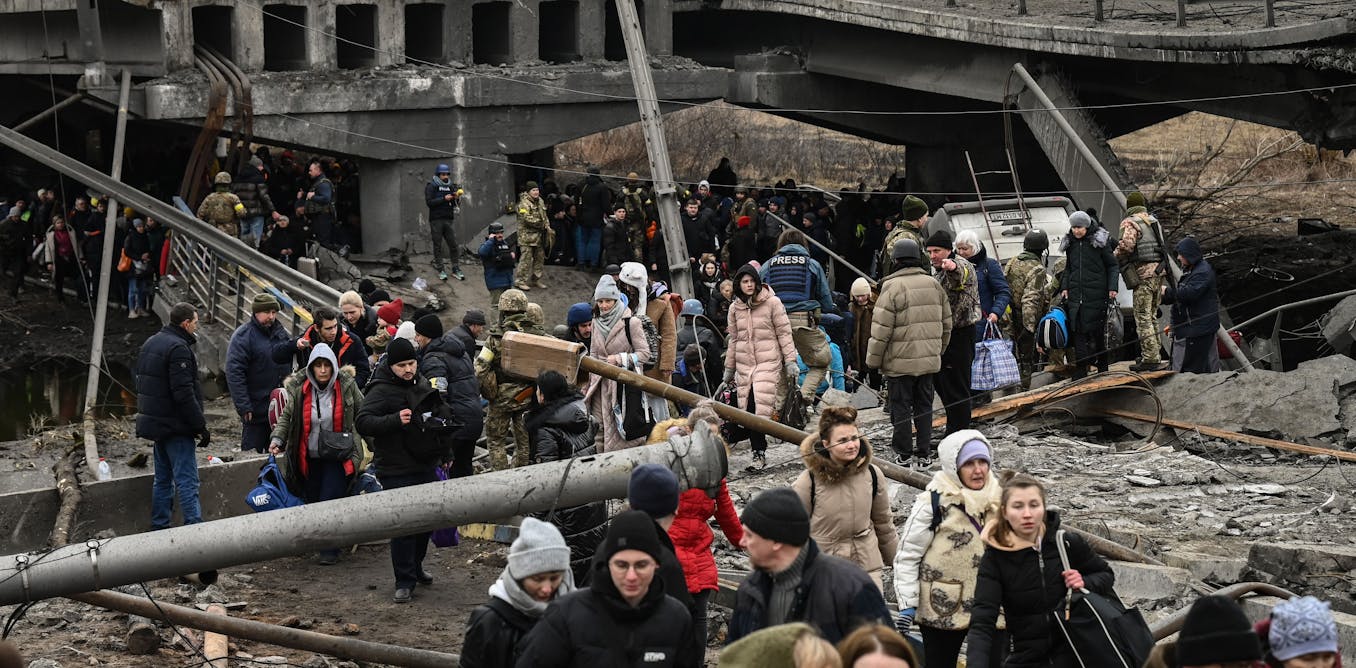
People cross a destroyed bridge as they evacuate the city of Irpin, northwest of Kyiv, during heavy shelling and bombing on March 5, 2022.
Across Europe, countries are preparing for the 4 million to 7 million Ukrainian refugees who will likely flee the Russian invasion of their country.
European Commission President Ursula von der Leyen spoke for many European leaders when she proclaimed, “Everyone who has to flee Putin’s bombs will be welcomed with open arms.”
Some European commentators on Western media have described Ukrainian refugees as being “civilized,” “middle class” and “prosperous,” and different from those from “third world nations.”
A few European politicians have also stressed that Ukrainian refugees are qualitatively superior by virtue of their race and religion to those from countries in Latin America, Asia, Africa and Oceania – collectively known as the Global South.
“These people are Europeans,” Bulgarian Prime Minister Kiril Petkov said, referring to Ukrainians.
“These people are intelligent,” Petkov explained. “They are educated people. … This is not the refugee wave we have been used to, people we were not sure about their identity, people with unclear pasts, who could have been even terrorists.”
As a scholar of refugees and forcible displacement, I find the European Union’s response to Ukrainian refugees a stark contrast with the treatment of the international students, African and Asian migrants and the untold number of refugees and asylum-seekers of color from Syria, Afghanistan and Bangladesh also fleeing Ukraine.
As scholars of race and racism in Europe have explained, and reports on race relations confirm, the European response is also consistent with the racism, Afrophobia and Islamophobia that have historically defined EU’s immigration system.
For years, these dynamics have led to the suffering and deaths of people from Africa, the Middle East and South Asia.
Anti-immigrant hostilities
The Ukrainian crisis is not the first refugee crisis that Europe has experienced since the 1990s. The 1989–1992 collapse of the Soviet Union resulted in 9 million people being uprooted. The collapse of former Yugoslavia and the 1992–1995 Bosnian genocide produced over 2 million refugees.
The wars in Afghanistan and Iraq and the 2011 Arab Uprisings in the Middle East led to an increase in the numbers of refugees trying to enter Europe. Even Turkey, already a host to over 4 million refugees and asylum-seekers – 3.6 million of whom are Syrians – could not adequately provide them with sanctuary.
But the response to these refugees of color has been overwhelmingly hostile.
Since 2014, Serbian, Macedonian and Hungarian authorities have used batons, stun grenades and tear gas on Afghan, Syrian, Iraqi and other asylum-seekers, including children and pregnant women, at their borders.
Hungarian and Croatian authorities have used attack dogs and forced migrants to strip naked in freezing temperatures.
In Bulgaria and Hungary, armed vigilantes hunt asylum-seekers at the border.
Hostile anti-immigrant policies have also been on the rise. Deportations have increased. Police harassment and abuse of asylum-seekers – including children – from Afghanistan, Pakistan, Bangladesh, Guinea, the Democratic Republic of Congo and other African countries are common in France.
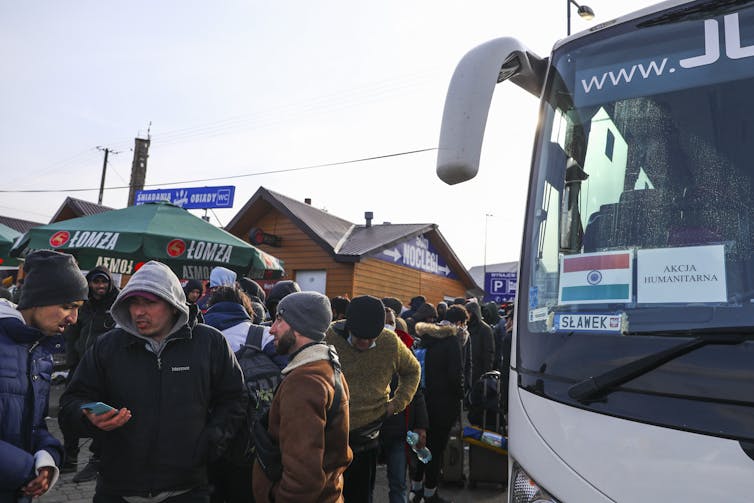
Non-Ukrainian citizens from India, Africa and the Middle East on March 1, 2022, after crossing the Ukrainian-Polish border in Medyka, Poland.
There are other blatantly anti-immigrant measures.
Harsh laws have been implemented in predominantly low-income Muslim immigrant areas in Denmark, which the government has classified as “ghettos”. Those who are denied asylum are moved to a detention facility on Lindholm Island, which previously housed laboratories for infectious diseases.
Greece also has increased security at sea and has built concrete walls around its refugee camps. According to the International Rescue Committee, Greece has cut down on camp services, creating a hunger crisis severely affecting 40% of the 16,559 refugee residents, including children.
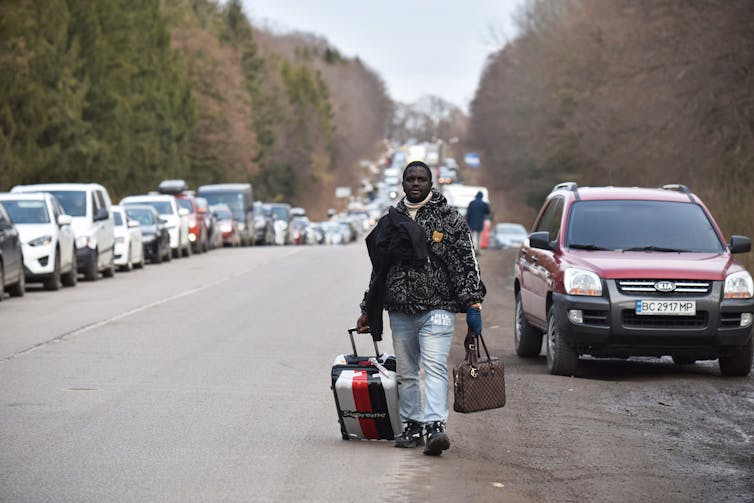
A Black man walks to the Shehyni checkpoint to cross the Ukrainian-Polish border on March 1, 2022, after Russia’s invasion.
In 2021, several hundred Afghan, Syrian, Iraqi and other asylum-seekers were stranded in forests and marshlands along the Poland-Belarus border, without shelter, food or water in freezing temperatures and facing regular violence by Polish and Belarusian border guards. There were at least a dozen deaths, including of children. European countries were refusing to open the border.
Fortress Europe
Though the European continent celebrated the fall of the Berlin Wall, wall-building has been on the rise in the region since the 1990s, despite the fact that walls remain an ineffective way to address the movement of refugees and migrants.
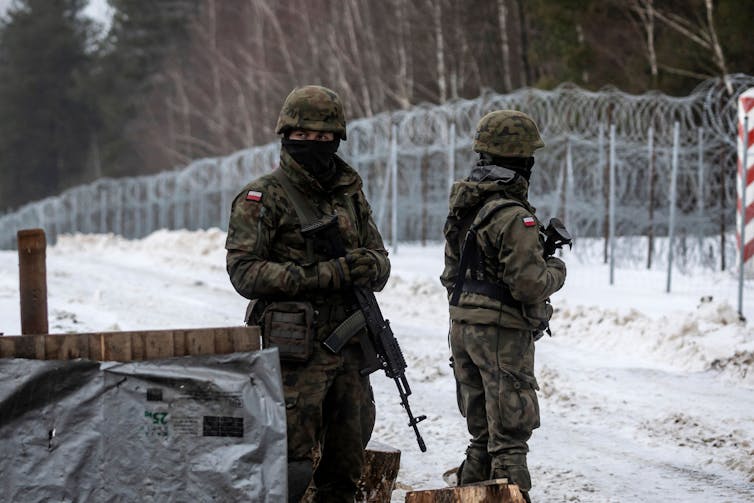
Before the Russian invasion of Ukraine, Polish soldiers are seen patrolling along the Polish-Belarusian border on Jan. 25, 2022, to prevent thousands of migrants from the Middle East from crossing into Poland.
According to the 2018 Transnational Institute report, the primary purpose of these walls is to deter refugees and asylum-seekers coming from the Global South.
Of the 27 members of the EU, 10 have built over 1,100 miles of walls to deter irregular arrivals.
These steel and concrete walls and fences are often fortified with advanced technology. Hungary’s walls, for instance, deliver electric shocks and are equipped with heat sensors and infrared cameras.
In 2021, Greece completed its wall along the border with Turkey to prevent the entry of Afghan asylum-seekers. The Spanish government now plans to build the highest wall - 32 feet - around Ceuta and Melilla in northern Morocco where the Spanish government claims authority to prevent migrant entry in Spain less than 250 miles away.
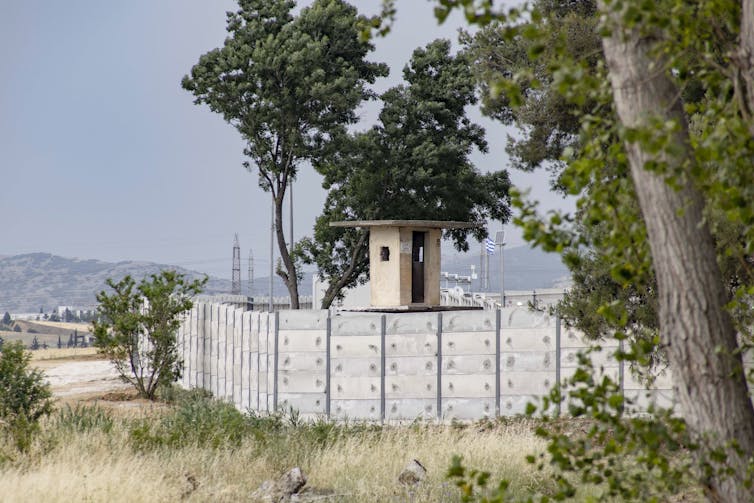
View in 2021 of a nearly 10-foot high, concrete wall built around the Diavata refugee camp near Thessaloniki, Greece.
Since 2021, Lithuania has been building an 11-foot-high steel fence, with 2-inch-thick razor wire, on its border with Belarus to prevent entry of migrants from the Middle East and North Africa.
Border walls at sea
Europe has intensified its border fortifications against refugees and asylum-seekers from outside the continent in other ways.
What are called “maritime walls” around Europe involve extensive naval and air operations in the Mediterranean. In 2021, the annual budget for Frontex – the agency responsible for the European Union’s border management and deterrence of migrant arrivals – increased from US$6.5 million in 2005 to over $593 million in 2021.
There is growing evidence that Frontex directly and indirectly supports violent interceptions of migrant boats in the Mediterranean, driving them back to North Africa. Such interceptions ignore distress calls at sea and often forcibly hand over migrants often to Libyan coast guards. The EU is aware of what has been described as egregious human rights violations of migrants in Libya.
Search and rescue operations at sea by private European citizens and nongovernmental organizations have also been criminalized with severe penalties
Since the pandemic began, EU nations enacted emergency legislation, increased sea interceptions and withdrew rescue operations.
According to the International Organization for Migration, EU policies have made the Mediterranean the deadliest migrant route, with over 23,500 missing migrants, presumably dead, since 2014. Among critical scholars of migration, the long history of racial subordination of Black Africans in Europe has meant that the sea is also called the Black Mediterranean.
Welcoming Ukrainian refugees only
The early response to Ukraine’s crisis, however, shows that for some refugees, at least, Europe has room.
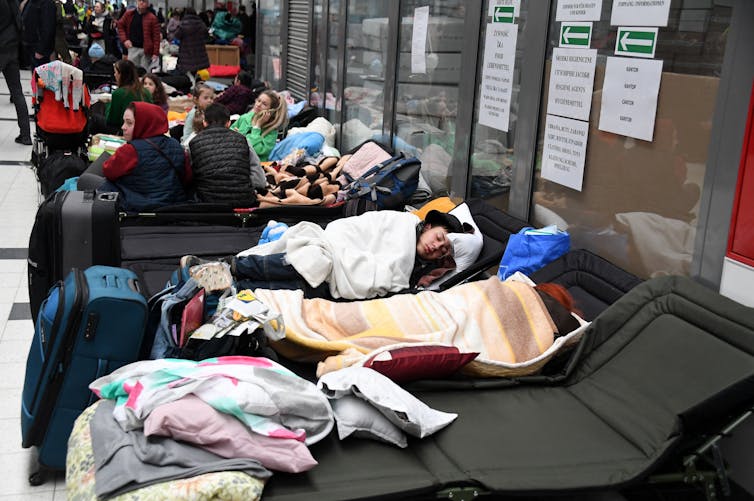
People rest at a refugee reception center at the Ukrainian-Polish border crossing in Korczowa on March 5, 2022.
EU members have unanimously agreed to accept Ukrainian refugees for up to three years without asking them to apply for asylum.
As of March 7, 2022, over 2 million refugees have already fled Ukraine, according to the United Nations High Commissioner for Refugees.
Poland has committed to accepting 1 million Ukrainians. Lithuania, Hungary, Latvia, Romania, Moldova, Greece, Germany and Spain have already opened their borders.
Britain, no longer a member of the EU, did not agree to visa waivers for Ukrainians. It initially limited settlement to immediate family members of British nationals.
But pressure is building among British citizens, activists and scholars to welcome more Ukrainian refugees at a time when other refugees remain just that – other.

